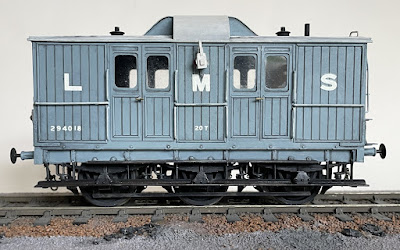Nothing was easy constructing my Small Goods engine and the same was true when I came to paint it; my choice of paint, Precision P727 Dark Green 1905-1912, which suits the unlined Drummond II livery is now permanently deleted, only P725 Light Green remains in stock. I had a small tin of this fortunately and I experimented by using it as the base colour. I added matt black and by a process of trial and error found that simply adding black and nothing else made a credible match for the lost 727. You can judge yourselves from the pictures displayed here the degree of my success. I have no infallible recipe for the colour, making it was a haphazard business and dependent on continued supplies of 725.
Despite keeping my precious mix in a tightly lidded jar, to my dismay it dried up to a jelly overnight before I'd painted the cab interior. So I embarked on a further experiment using Revell semi-matt Dark Green 363 as a base. I added a good deal of matt black and rather less yellow (15) which produced a credible colour for the cab. I think success depends on the base colour being as near as possible to the colour you're aiming to mix.
The cab interior is based on the drawing in Peter Tatlow's "Highland Locomotives" (p.57), showing the interior of a Loch Class engine of 1896. I think the cab of the Jones rebuild of the Small Goods was probably much the same as that of a Jones designed Loch. The backhead owes much to a Lochgorm Kits etched sheet; brass castings are mainly sourced from Laurie Griffin and 62C Models, revised to fit this particular cab. The oil can and grating visible in the center are my own white metal castings.

 |
|
The dark green base colour, mixed from my own recipe (above), was applied with a Badger Anthem 155 airbrush. The contrasting areas of black were brush painted using Humbrol matt black to which a touch of talc was added; when dry these areas were buffed with a soft toothbrush to produce a sheen. Transfers on the buffer beam and rear of the tender are methfix type from a rather depleted Guilplates sheet of Highland Locomotive transfers which are sadly no longer available. The number and maker's plates were etched to order by Light Railway Stores.
The driver and fireman are my own sculpture though now available from Chris Smith at Invertrain Models in his "Heroes of the Footplate" range. The figures are designed with contrasting poses which maximise the restricted space available in the cab and by avoiding standing shoulder-to-shoulder they allow a good view of the interior and of the backhead details.
The 4 ton capacity tender is identified by 9" Highland numerals. Design of these early tenders owed a debt to those of the LNWR, the coal had to be shoveled from floor level, a back breaking task.
The tablet catching apparatus has a handle which goes into the cab between the side sheet and the stanchion. The fall-plate is shaped to clear the sand-boxes and allow the engine to negotiate curves on a club layout and also masks the un-prototypical, though most effective way, the engine hooks to the tender.
.JPG)
.jpg)
.JPG)
.JPG)










































